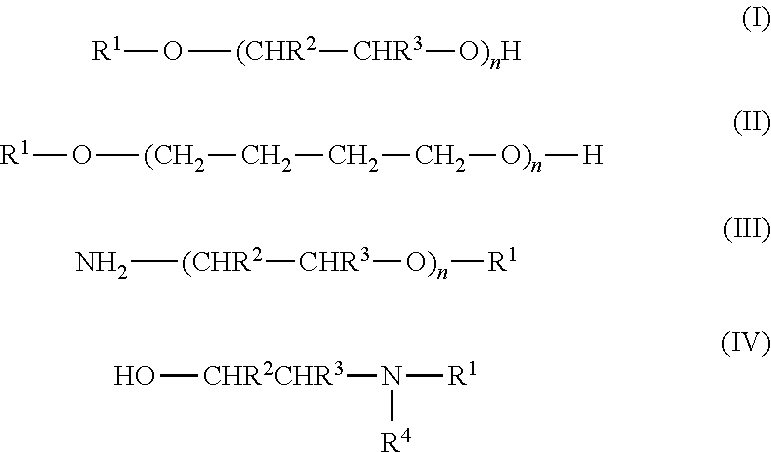Small particle size telomers of methacrylic acid or anhydride
a technology of methacrylic acid or anhydride and small particle size, which is applied in the field of comb polymers from small particle size telomers of methacrylic acid and anhydride, can solve the problems of limiting the processing flexibility, limiting the ease with which one can make superplasticizers, and the method of making (pmaa) polymers and copolymers in moro et al. provides a low yield upon esterification or amidation, and achiev
- Summary
- Abstract
- Description
- Claims
- Application Information
AI Technical Summary
Benefits of technology
Problems solved by technology
Method used
Image
Examples
examples 1 , 2 and 3
Examples 1, 2 and 3
Fine Particle Size Polycarboxylates
[0061]Materials were esterified to make comb polymers. First, a hypophosphite telomer of methacrylic acid having a weight average molecular weight of ≈6000 was heated at 150° C. for 2 hours to drive off the water and was used as Example 1. A portion of the oven dried hypophosphite containing polymethacrylic acid (pMAA) was then heated at 200° C. for 30 minutes to convert the acid to polymethacrylic anhydride (pMAAn) which was Example 2. Also persulfate initiated pMAA having a Mw of 6,500 was used in Example 3. All three materials were ground using a mortar and pestle followed by further grinding with a Retsch (Newtown, Pa.) MM400 ball mill at 30 hz for 2 minutes. The particle size analysis was done on dry material with a Beckman-Coulter (Brea, Calif.) LS 13 320 Laser Diffraction Particle Size Analyzer (Beckman-Coulter, Brea, Calif.). The resulting mean particle sizes are shown in Table 1, below.
[0062]
TABLE 1Particle Size Analysis...
examples 7 and 7a
Hand Ground Small Particle Size Phosphorus Oxide Telomers
[0070]The polymers of Example 7 and 7A were, respectively, a pMAA hypophosphite telomer and persulfate telomer heated at 150° C. for 2 hours to drive off the water. Both were then hand pulverized with a pestle and mortar. The particle size of the dry material was evaluated and measured with a Beckman-Coulter LS 13 320 Laser Diffraction Particle Size Analyzer (Beckman-Coulter, Brea, Calif.). The results are shown in Table 4, below.
[0071]
TABLE 4Particle Size AnalysisMean Particle ExampleSize (μm)7562.97A744.4
Examples 8, 8A, 8B,8C, 9 and 9A
Superplasticizer Reactant Formulations
[0072]As shown in Table 5, below, formulations of superplasticizer reactants comprised a polyether side chain forming reactant and the dried polymers of Examples 7 and 7A, including a 2,000 Mw poly(ethylene glycol) methyl ether (mPEG2K) (Aldrich Chemicals, St. Louis, Mo.) and an mPEG 5,000 poly(ethylene glycol) methyl ether Polygylkol™ M 5,000S (Clariant Co...
examples 11 , 12 , 13 and 14
Examples 11, 12, 13 and 14
Fine Particle Size (Co)telomers
[0080]Materials were esterified to make comb polymers. First, the sulphonate (from bisulfite) and sulfate (from persulfate) group containing telomers of methacrylic acid were heated at 150° C. for 2 hours to drive off the water. These polymethacrylic acid (pMAA) telomers were used as Example 12 and 14. A portion of the oven dried pMAA telomers of Examples 12 and 14 were then heated at 220° C. for 30 minutes to convert the acid to anhydride (pMAAn) telomers, respectively, in Examples 11 and 13. All four materials were ground using a mortar and pestle followed by further grinding with a Retsch (Newtown, Pa.) MM400 ball mill at 30 hz for 2 minutes. The particle size analysis was done on dry material with a Beckman-Coulter (Brea, Calif.) LS 13 320 Laser Diffraction Particle Size Analyzer (Beckman-Coulter, Brea, Calif.). The resulting mean particle sizes are shown in Table 7, below.
[0081]
TABLE 7Mean Particle SizeExampleMaterialMean...
PUM
| Property | Measurement | Unit |
|---|---|---|
| particle size | aaaaa | aaaaa |
| temperature | aaaaa | aaaaa |
| molecular weight | aaaaa | aaaaa |
Abstract
Description
Claims
Application Information
 Login to View More
Login to View More - R&D
- Intellectual Property
- Life Sciences
- Materials
- Tech Scout
- Unparalleled Data Quality
- Higher Quality Content
- 60% Fewer Hallucinations
Browse by: Latest US Patents, China's latest patents, Technical Efficacy Thesaurus, Application Domain, Technology Topic, Popular Technical Reports.
© 2025 PatSnap. All rights reserved.Legal|Privacy policy|Modern Slavery Act Transparency Statement|Sitemap|About US| Contact US: help@patsnap.com

